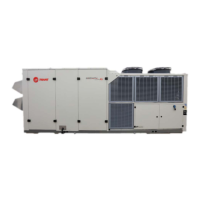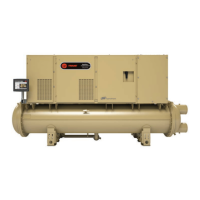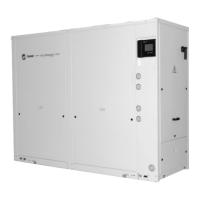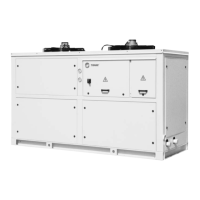Do you have a question about the Trane Airfinity XL IC140 and is the answer not in the manual?
Introductory remarks about the manual's purpose and scope for Trane Airfinity rooftop units.
Highlights potential hazards and precautions for safe operation and servicing to prevent injury or equipment damage.
Lists essential safety guidelines to avoid death, injury, or property damage during maintenance and service.
Procedures for inspecting units upon arrival, checking for damage, and reporting claims to the carrier.
Instructions to verify all accessories and loose parts shipped with the unit against the provided list.
Details the warranty terms and conditions, voiding conditions, and limitations for equipment use and maintenance.
Refers to addendum for conformity to Pressure Equipment Directive and Machinery Directive for units with refrigerant.
Strongly recommended contract for regular maintenance by specialists to ensure optimal operation and longevity.
Precautions to prevent condensate formation inside electrical components and motors during storage.
Information on available service school for operators and technicians to enhance equipment knowledge.
Detailed explanation of each digit's meaning in the unit model number for configuration identification.
Net cooling capacity and total power input for R410A and R454B refrigerants across different models.
Details on electric heater capacity steps and values for various unit models.
Technical data for Low, Standard, and High Heat gas burners, including output, efficiency, and modulation.
Specifications for the hot water coil, including net heating capacity, tube size, and physical dimensions.
Main power supply, unit max amps, start-up amps, and short circuit ratings for different unit configurations.
Information on compressor circuits, type, model, max amps, and locked rotor amps per compressor.
Details on oil quantity per compressor/circuit and refrigerant load for R410A and R454B.
Data for outdoor coils including tube size, face area, and rows/fin series.
Technical details for standard and oversized indoor fans, including airflow, motor power, and RPM.
Specifications for standard ambient outdoor fans, including airflow, motor power, and RPM.
Details on filter types, sizes, and number of filters per layer for indoor air filtration.
Overall physical dimensions and operating weight of the unit without auxiliary heat.
Weights added by optional components like hot water coil, electric heater, and gas burners.
Specifications for Energy Recovery Modules (HRW Airfinity XL) including wheel type, diameter, and fans.
Net cooling and heating capacities and total power input for R410A and R454B refrigerants.
Details on electric heater capacity steps and values for various unit models.
Technical data for Low, Standard, and High Heat gas burners, including output, efficiency, and modulation.
Specifications for the hot water coil, including net heating capacity, tube size, and physical dimensions.
Main power supply, unit max amps, start-up amps, and short circuit ratings for different unit configurations.
Information on compressor circuits, type, model, max amps, and locked rotor amps per compressor.
Details on oil quantity per compressor/circuit and refrigerant load for R410A and R454B.
Data for outdoor coils including tube size, face area, and rows/fin series.
Technical details for standard and oversized indoor fans, including airflow, motor power, and RPM.
Specifications for standard ambient outdoor fans, including airflow, motor power, and RPM.
Details on filter types, sizes, and number of filters per layer for indoor air filtration.
Overall physical dimensions and operating weight of the unit without auxiliary heat.
Weights added by optional components like hot water coil, electric heater, and gas burners.
Specifications for Energy Recovery Modules (HRW Airfinity XL) including wheel type, diameter, and fans.
Diagram illustrating the refrigerant circuit and components of the Airfinity XL IC units.
Diagram showing the refrigerant circuit and components for the Airfinity XL IH units.
Guidelines for inspecting units upon delivery, handling procedures, and lifting instructions.
Information on installing roof curbs for unit placement, ensuring water tightness and proper support.
Requirements for unit support structures, ensuring stability and level placement on foundations or roof.
Guidance on selecting unit location for optimal air circulation and required maintenance clearances.
Diagrams showing the outdoor and indoor sections of the unit with key components labeled.
Information on unit physical dimensions, weights, and required clearances for installation and service.
Recommendations for ductwork construction, canvas connectors, elbows, and insulation for noise and vibration.
Instructions for connecting the condensate drain, including P trap requirement and slope for adequate flow.
Guidance on accessing and installing air filters, including available combinations and filter types.
Procedures for adjusting and verifying supply fan airflow to match design specifications for optimal performance.
Explanation of the airflow measurement option using differential pressure sensors and calculation methods.
Details on the integrated R454B refrigerant leak detector, its installation, and function.
Guidelines for installing gas piping, including pressure requirements, leak testing, and safety precautions.
Information on exhaust pipe connection adapters and features for smoke and flue gas outlets.
Mandatory guidelines for field-installed wiring, grounding, and compliance with local regulations and CE directives.
List of components that the installer must provide for field-wired connections and devices.
Information on the location of the electric panel and requirements for power supply connections.
Critical steps for ensuring proper electrical phasing and rotation for scroll compressor operation and reliability.
Explanation of the blink codes generated by the motor protector's status LED for troubleshooting.
Overview of the Energy Recovery Module, its function, and general installation considerations.
Step-by-step instructions for installing the HRW module in a horizontal flow configuration.
Step-by-step instructions for installing the HRW module in a down flow configuration.
Procedures for preparing the HRW module and its supports for installation onto the unit.
Detailed steps for locating, positioning, and connecting the HRW module to the main unit.
Instructions for assembling and installing the fresh air hood for both horizontal and down flow units.
Visual overview of the Heat Recovery Module components for horizontal and down flow configurations.
Graphical representation of unit operating limits in cooling mode based on ambient and return air temperatures.
Operating map indicating the freecooling area and conditions for enhanced energy efficiency.
Graphical representation of unit operating limits in heating mode based on ambient and return air temperatures.
Features and functions related to managing building air pressure, including barometric relief.
Explanation of the barometric relief function to minimize building overpressure caused by fresh air intake.
Instructions for installing the fresh air hood, a standard feature with the economizer unit.
Details on EC exhaust plug fans used to minimize building overpressure and their operational modes.
Information on the Hot Water Coil option for additional heating, its connections, and antifreeze protection.
Description of the electric heater option, including heating stages and overheat thermostat functions.
Information on the premix burner module, including its components and gas pressure drop characteristics.
Overview of the main CH536 control module and its capabilities with extension modules.
Description of the optional service terminal for unit parameter adjustment, monitoring, and diagnostics.
Diagram illustrating the internal control hardware bus connections for system components.
Summary of available zone temperature sources and their hierarchy for unit control.
Details on the CO2 sensor function, placement, and maintenance recommendations for comfort control.
Information on optional fire thermostat and the clogged filter detector's function and location.
Description of the smoke detector's role in shutting off the unit and activating an alarm.
List of other available control accessories such as temperature sensors and thermostats.
Explanation of how alarms and warnings affect unit operation and how they are accessed via the control display.
Details on refrigerant leak detection, alarm response, and unit behavior upon leak detection.
Details on the customer option module's inputs and outputs, and their definition via the service terminal.
Explanation of unit mode control when using a conventional thermostat interface.
Overview of four strategies for demand control ventilation within the economizer system.
Description of external requests for override modes like pressurize, purge, and exhaust during emergencies.
Checklist of essential procedures and checks before initiating unit start-up.
Instructions for power-up initialization and ensuring crankcase heaters are energized.
Guidance on installing pressure gauges and checking operating pressures after initial unit run.
Steps for the initial start-up of the gas burner, including gas category checks and combustion analysis.
Explanation of the unit's interface panel, including display status, menu structure, and indicator lights.
Periodic maintenance tasks that can be performed by the end user, including filter and coil cleaning.
Maintenance checks recommended for service technicians before cooling and heating seasons.
How to use the control display for diagnostics and troubleshooting unit operation issues.
Annual calibration procedures for the refrigerant leak detector using sensor replacement or on-site calibration.
Key steps for unit commissioning, including control configuration, calibration, and leak testing.
Specific maintenance tasks for gas heating systems, including gas train checks and flue gas analysis.
Maintenance tasks for electric heating elements, focusing on electrical connections and operation.
Maintenance checks for hot water/steam coils, valves, and related heating system components.
Tasks to be performed during the 500/1000 hours visit, including oil replacement and leak tests.
Activities performed during an inspection visit, such as leak tests, contact checks, and coil condition review.
Comprehensive annual maintenance tasks covering set points, safety devices, and system analysis.
Mandatory annual calibration for the refrigerant leak detector to ensure accuracy and proper operation.
Predictive tool for detecting minor issues in oil, reducing failure detection time and optimizing maintenance.
Thorough analysis for refrigerant contamination and recommendations for solution upgrades.
Tailored maintenance and service programs offering various coverage levels to suit customer requirements.
Optional service providing a 5-year part and labor warranty specifically for the motor compressor.
Solutions designed to optimize energy efficiency in existing systems and generate immediate savings.











